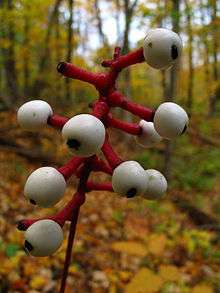Actaea (plant)
| Actaea | |
|---|---|
 | |
| Actaea rubra | |
| Scientific classification | |
| Kingdom: | Plantae |
| (unranked): | Angiosperms |
| (unranked): | Eudicots |
| Order: | Ranunculales |
| Family: | Ranunculaceae |
| Genus: | Actaea L. |
| Species | |
|
See text | |

Actaea, commonly called baneberry or bugbane, is a genus of flowering plants belonging to the family Ranunculaceae, native to subtropical, temperate and subartic regions of the Europe, Asia and North America, but the majority is endemic to parts of North America.
The genus is closely related to Cimicifuga and Souliea, and many botanists include those genera within Actaea (e.g., Compton et al. 1998, Compton & Culham 2002, Gao et al. 2006, RHS Plant Finder, 2007) based on combined evidence from DNA sequence data, similarity in biochemical constituents and on morphology; if included, the number of species in Actaea rises to 25-30. Other botanists (e.g., Hoffman 1999, Wang et al. 1999, Lee & Park 2004) reject this merger because only one group (Actaea) have fleshy fruit while the remainder have dry fruit. The genus is treated here in its broader sense.
- Selected species
- Actaea arizonica – Arizona bugbane
- Actaea asiatica
- Actaea elata
- Actaea pachypoda – white baneberry, white cohosh, doll's eyes
- Actaea podocarpa
- Actaea racemosa – black cohosh, black bugbane
- Actaea rubra (syn. Actaea erythrocarpa) – red baneberry
- Actaea spicata (syn. Actaea alba) – baneberry, herb christopher
The name Actaea alba (L.) Mill. is a confused one (Fernald 1940); although described as an American species (now named A. pachypoda), the illustration on which the description was based was actually a picture of the European A. spicata, and strictly, the name is therefore a synonym of the European species. Some texts, however, still treat A. pachypoda under this name.
Actaea is recorded as a food plant for the larva of the Dot Moth.
Use and toxicity
Baneberry contains cardiogenic toxins than can have an immediate sedative effect on human cardiac muscle. The berries are the most poisonous part of the plant (hence the name baneberry). Children have been poisoned by eating the waxy, shiny red or white berries. Ingestion of the berries can lead to cardiac arrest and death. It is toxic to rabbits.[1] The berries are harmless to birds, the plant's primary seed disperser. Actaea species are closely related to plants in the genus Aconitum, a highly toxic plant genus which contains wolfbane and several varieties of monkshood.[2]
The roots of A. rubra contain β-sitosterol glucoside,[3] and they were used medicinally by Native Americans as an alternative to Black Cohosh, (A. racemosa), for menstrual cramping and menopausal discomfort.
References
Notes
- ↑ http://www.medirabbit.com/EN/GI_diseases/Food/Toxic_plants_en.pdf[]
- ↑ Edible and Medicinal Plants of the West, Gregory L. Tilford, ISBN 0-87842-359-1
- ↑ Ali, Zulfiqar; Khan, Shabana; Khan, Ikhlas (2006). "Phytochemical Study of Actaea rubra and Biological Screenings of Isolates". Planta Medica. 72 (14): 1350–2. doi:10.1055/s-2006-951696. PMID 17024608.
Sources
- Compton, J. A.; Culham, A.; Jury, S. L. (1998). "Reclassification of Actaea to Include Cimicifuga and Souliea (Ranunculaceae): Phylogeny Inferred from Morphology, nrDNA ITS, and cpDNA trnL-F Sequence Variation". Taxon. 47 (3): 593–634. doi:10.2307/1223580. JSTOR 1223580.
- Compton, James A.; Culham, Alastair (2002). "Phylogeny and Circumscription of Tribe Actaeeae (Ranunculaceae)". Systematic Botany. 27 (3): 502–11. doi:10.1043/0363-6445-27.3.502. JSTOR 3093958.
- Fernald, M. L. (1940). "What is Actaea alba?". Rhodora. 42: 260–5.
- Gao, Jing-Chun; Zhang, Jin-Chao; Lu, Zhi-Jian; Zhu, Guo-Yuan; Yang, Meng-Su; Xiao, Pei-Gen (2006). "Chemical constituents of Actaea asiatica Hara and their anti-osteoporosis activities". Biochemical Systematics and Ecology. 34 (9): 710–13. doi:10.1016/j.bse.2006.02.004.
- Hoffmann, Matthias H. (1999). "The phylogeny of Actaea (Ranunculaceae): A biogeographical approach". Plant Systematics and Evolution. 216 (3–4): 251–63. doi:10.1007/BF01084402.
- Lee, Hyun-Woo; Park, Chong-Wook (2004). "New Taxa of Cimicifuga (Ranunculaceae) from Korea and the United States" (PDF). Novon. 14 (2): 180–184. JSTOR 3393313.
- RHS Plant Finder https://web.archive.org/web/20070711161100/http://www.rhs.org.uk:80/RHSPlantFinder/plantfinder.asp
- Wang, Wen-Tsai; Li, Liang-Qian; Wang, Zheng (1999). "Notulae de Ranunculaceis sinensibus (XXIII)". Acta Phytotaxonomica Sinica. 37 (3): 209–19.
- Germplasm Resources Information Network: Actaea (treats genus in broad sense)
- Flora of China: Actaea (treats genus in narrow sense)
- Flora of North America: Actaea (treats genus in narrow sense)
- Edible and Medicinal plants of the West, Gregory L. Tilford, ISBN 0-87842-359-1
| Wikimedia Commons has media related to Actaea. |